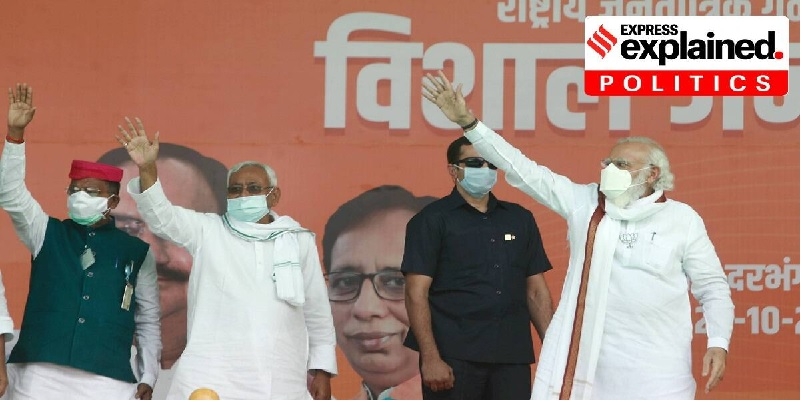Bihar Verdict Boosts BJP
| Date :21-Nov-2020 |

BJP, earlier known as a party of only upper castes, under Modi’s leadership has been able to reach among the economically poor sections of the society irrespective of caste — OBCs, Dalits and upper castes — and religion. This well reach out of welfare schemes also created a new vote bank for the BJP — the women voters.
THE Bihar verdict has compelled many political commentators to wonder how come the incumbent National Democratic Alliance (NDA) Government led by Chief Minister Nitish Kumar of JD(U) was able to come back to power again amid the coronavirus pandemic. After all, it’s a fact that the Nitish Government failed to address the worst migrant crisis in recent times that the State had to face during this pandemic. The Biharis working in other States were forced to move out during the lockdown to reach back their homes — as a result the State showed a sudden rise of unemployment level.
All such factors are enough for the Opposition, the Mahagatbandhan led by RJD, which this time too managed to emerge as the single largest party, to oust the incumbent Government — but in case of Bihar, it didn’t happen. Although the fight was very close, clear signs of anti-incumbency against the Nitish Government, the ruling NDA somehow managed to return back to power with BJP having the best strike rate and having more seats than its ally JD(U). So, post the verdict, the assumption by a section of political commentators is that finally the caste and religion factors triumphed over basic issues like employment and development.
True that identity politics have their own roles in determining the election results not only in Bihar but in elections held across the country — and even across the parts of the world. The assumption that people blindly vote on caste and religious lines isn’t that true.
During RJD founder Lalu Prasad Yadav’s rule, the focus was mainly on Yadavs and Muslims — a major reason why these two communities are regarded as strong vote banks of the party. Although, this time in Muslim dominated Seemanchal region, Asaduddin Owaisi’s AIMIM ate into some of RJD’s Muslim votes. But one should remember that during the last Assembly elections of 2015, the strong polarisation of Yadavs and Muslims behind the RJD was one of the main reasons behind the Mahagatbandhan’s victory — JD(U) too was part of the grand alliance then. However, in the circles of many political analysts only BJP is held responsible for causing caste and religious polarisation — when “secular” parties too are equally responsible for such polarisations!
On the other hand, the NDA in Bihar under Nitish Kumar, through his politics of social justice and welfare schemes, tried to reach out to the backward and the Dalit sections. Nitish Government’s decision to reserve 50% seats for women in panchayat bodies and to distribute free bicycles to girls created a new vote bank for JD(U) — the women vote bank. Also, his Government’s decision to ban alcohol in the State, although not properly implemented, solidified his women vote bank. Not only this, Nitish also focused on law and order and development of the State by constructing roads and bridges.
Apart from this, the Prime Minister Narendra Modi led BJP Government’s welfare schemes focusing on providing cooking gas, opening of bank accounts under the Jan Dhan Yojana, direct money transfer, building toilets and pucca houses, treating poor freely with an insurance scheme of Rs 5 lakh under the Ayushman Bharat, the world’s largest healthcare scheme, making electricity available to distant rural parts and also concentrating on construction of roads helped the saffron party to widen its social base. As a result, BJP, earlier known as a party of only upper castes, under Modi’s leadership has been able to reach among the economically poor sections of the society irrespective of caste — OBCs, Dalits and upper castes — and religion. This well reach out of welfare schemes also created a new vote bank for the BJP — the women voters.
Significantly, during this Coronavirus pandemic, these welfare schemes of Modi Government also benefited the marginalised sections hugely — like the free distribution of ration, cooking gas and direct money transfer under the Pradhan Mantri Garib Kalyan Yojana. Also, the Ayushman Bharat is coming handy for the poor during this pandemic.
No doubt that caste and religious factors obviously do benefit all political parties in Bihar elections but this Bihar verdict also reflects the success of social, welfare and development politics. The statistics also suggest that large participation of women voters contributed to NDA’s victory.
True, that there was a strong anti-incumbency against Chief Minister Nitish Kumar — a reason enough for voters electing more BJP MLAs than JDU for the first time. This time in Bihar, the anti-incumbency changed the internal power scenario of the ruling NDA coalition — instead of voting it out of power.
Bihar verdict confirms that Modi’s popularity, despite the pandemic, is intact and under his leadership, BJP now has a broad social base. Addition to this, the BJP has a strike rate of 65% against RJD in direct contests — this breaks the conventional myth that the BJP doesn’t do well when pitted against regional parties. This definitely gives strength to the BJP in the upcoming West Bengal Assembly polls to be held next year — where the BJP would contest against Trinamool Congress, a regional party. (IPA)